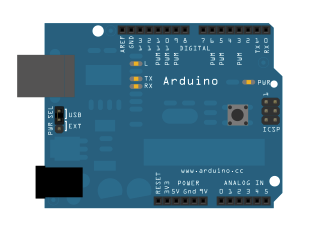Arduino内置教程-字符串-String Append Operator
String Appending Operators
- 就像你可以用StringAdditionOperator把字符串和其他数据对象连到一起一样,你也可以用 += 运算符和 concat() 命令来在字符串后面加其他东西。 += 运算符和 concat() 命令用同一种方式工作,随便你想选哪一种方式。下面两个例子说明这两种方法,并且得出同一个字符串:
String stringOne = "A long integer: ";
// using += to add a long variable to a string:
stringOne += 123456789;
- 或者
String stringTwo = "A long integer: ";
// using concat() to add a long variable to a string:
stringTwo.concat(123456789);
- 在这两种情况下,stringOne等于 "A long integer: 123456789"。就像+运算符,这些运算符对于往数据组合对象里增加长字符串很方便。
硬件要求
- Arduino or Genuino开发板
电路
- 这个例子没有额外的电路连接,除了你的开发板需要连接到你的电脑,并且打开Arduino IDE的串口监视器窗口。

图由 Fritzing 软件绘制
样例代码
/*
Appending to Strings using the += operator and concat()
Examples of how to append different data types to strings
created 27 July 2010
modified 2 Apr 2012
by Tom Igoe
http://www.arduino.cc/en/Tutorial/StringAppendOperator
This example code is in the public domain.
*/
String stringOne, stringTwo;
void setup() {
// Open serial communications and wait for port to open:
Serial.begin(9600);
while (!Serial) {
; // wait for serial port to connect. Needed for native USB port only
}
stringOne = String("Sensor ");
stringTwo = String("value");
// send an intro:
Serial.println("\n\nAppending to a string:");
Serial.println();
}
void loop() {
Serial.println(stringOne); // prints "Sensor "
// adding a string to a string:
stringOne += stringTwo;
Serial.println(stringOne); // prints "Sensor value"
// adding a constant string to a string:
stringOne += " for input ";
Serial.println(stringOne); // prints "Sensor value for input"
// adding a constant character to a string:
stringOne += 'A';
Serial.println(stringOne); // prints "Sensor value for input A"
// adding a constant integer to a string:
stringOne += 0;
Serial.println(stringOne); // prints "Sensor value for input A0"
// adding a constant string to a string:
stringOne += ": ";
Serial.println(stringOne); // prints "Sensor value for input"
// adding a variable integer to a string:
stringOne += analogRead(A0);
Serial.println(stringOne); // prints "Sensor value for input A0: 456" or whatever analogRead(A0) is
Serial.println("\n\nchanging the Strings' values");
stringOne = "A long integer: ";
stringTwo = "The millis(): ";
// adding a constant long integer to a string:
stringOne += 123456789;
Serial.println(stringOne); // prints "A long integer: 123456789"
// using concat() to add a long variable to a string:
stringTwo.concat(millis());
Serial.println(stringTwo); // prints "The millis(): 43534" or whatever the value of the millis() is
// do nothing while true:
while (true);
}
更多
- String object – 字符串对象的参考
- CharacterAnalysis - 使用operators来识别对应的特征类型。
- StringAdditionOperator - 用不同方法把字符串加到一起。
- StringAppendOperator - 用+=运算符和concat()方法来添加东西到字符串里。
- StringCaseChanges - 改变字符串的状态。
- StringCharacters - 在字符串里获得或设置一个指定的字符的值
- StringComparisonOperators - 按字母排列顺序地比较字符串
- StringConstructors - 初始化字符串对象
- StringIndexOf - 寻找在字符串里字符的第一个或最后一个的状态
- StringLength - 获得和修剪字符串的长度
- StringLengthTrim - 获得和修剪字符串的长度
- StringReplace - 替换字符串里的个别字符
- StringStartsWithEndsWith - 检查一个给定的字符或子串(substrings)的开始或结尾
- StringSubstring - 在给定的字符串里寻找"phrases"
- StringToInt - 允许你把字符串转换成整数数字